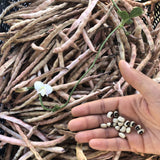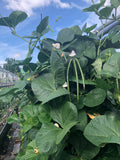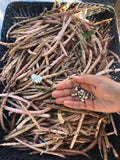Ezelle Family 'Fish Eye' Blackeyed Pea
Vigna unguiculata
Plump cream-colored peas with big, beautiful black eyes grow 10-15 to a pod on lovely, productive, and vigorous 6-foot-tall vines with white flowers. The tender young pods are a tasty treat in the garden, though these are primarily grown for shelling when fresh or dried.
We received these seeds from seed keeper extraordinaire Kris Hubbard, of Artemus, Kentucky, who has travelled the Appalachian hollows as a healer, ethnobotanist, and educator for decades, collecting seeds and stories along the way.
The Ezelle family is originally descended from Mali, West Africa. They were first enslaved on a plantation in Hahnville Parish, Louisiana from 1820-1860s. They were later split up and some were relocated to Chickasaw County, Mississippi. Kris received these seeds in the early/mid 1990s from an old-timer in his 80s named Ezelle who had married a Choctaw woman Kris knew. Mr. Ezelle said his grandmother had carried the pea from Louisiana by placing a few into a wilted leaf tucked under her hair. His mother who called the pea "Fish Eye" cared for them until he had his own garden.
Days to maturity: 65-80
Seeds per pack: 60
Germination rate: 90% on 11/20/2025
Planting / harvesting notes
Direct sow black-eyed peas safely after frost, any time between late May and mid-July. This is a climbing vine crop, so it needs to be planted next to a structure or trellis. Plant 1" deep with 3-4" spacing, either in 1 row on each side of the net trellis or in another arrangement if using a different kind of trellis, like a pole or garden sculpture. Being a legume, it does fairly well in and adds nitrogen to poor soil.
Seed keeping notes
Black-eyed peas are self-pollinating, though it is best to isolate different varieties of V. unguiculata (including black-eyed peas, southern peas, cowpeas, and long beans) at least 20 feet, if not much farther to avoid unwanted cross-pollination. Allow beans to dry fully into a brown crispy state. This is when they are ready to harvest for seed. If necessary, lay them out to dry a little longer in their pods.











